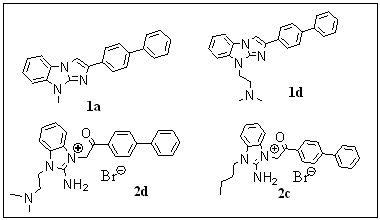Search for compounds with antioxidant and antiradical activity among N9-substituted 2-(biphenyl-4-yl)imidazo[1,2-a]benzimidazoles
DOI:
https://doi.org/10.3897/rrpharmacology.8.85498Аннотация
Introduction: Biphenyl and imidazobenzimidazole derivatives attract ongoing attention as a combination of these two privileged substructures with promising pharmacological activities. The aim of this study was to synthesize and investigate in vitro antioxidant activity of promising novel compounds: 2-(biphenyl-4-yl)imidazo[1,2-a]benzimidazoles.
Materials and methods: The newly synthesized compounds were characterized by IR, 1H NMR and CHBr(Cl)NO analyses. All newly synthesized compounds were screened for their in vitro antioxidant activity: inhibition of lipid peroxidation (LPO), 2,2’-azino-bis-(3-ethylbenzothiazoline-6-sulfonic acid) (ABTS•+) radical cation decolorization and inhibition of hemoglobin (Hb)-H2O2-induced luminol chemiluminescence.
Results and discussion: 2-Amino-3-[(2-biphenyl-4-yl)-2-oxo-ethyl)]-1-R-1Н-benzimidazolium bromides were synthesized, and their cyclization into functionalized imidazo[1,2-a]benzimidazole derivatives was studied. The resulting compounds showed LPO inhibitory activity comparable to that of dibunol. Compounds 1a and 1d (see graphical abstract), containing a methyl or dimethylaminoethyl substituent in the N9 position also proved to be equally highly active in the Hb-H2O2-induced luminol chemiluminescence model, while compound 1a was somewhat more active than 1d in the ABTS• radical scavenging assay.
Conclusion: The study showed that compounds 1a and 1d have the highest antioxidant activity. Thus, this new class of 2-(biphenyl-4-yl)imidazo[1,2-a]benzimidazole derivatives represents a valuable leading series with great potential for use as antioxidants and as promising candidates for further efficacy evaluation.
Graphical abstract:
 Русский
Русский
 English
English

